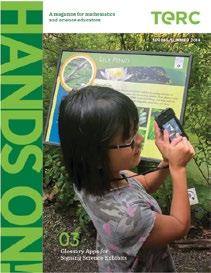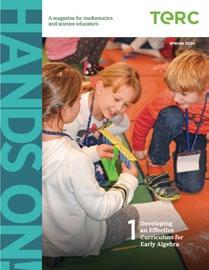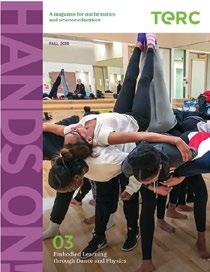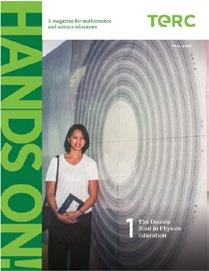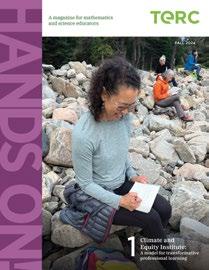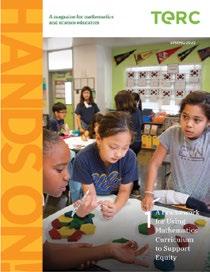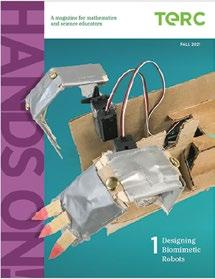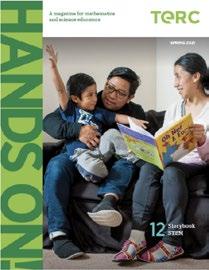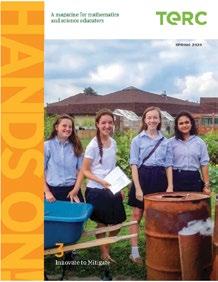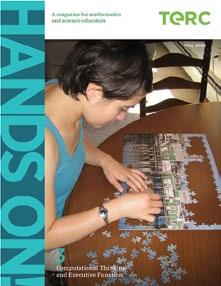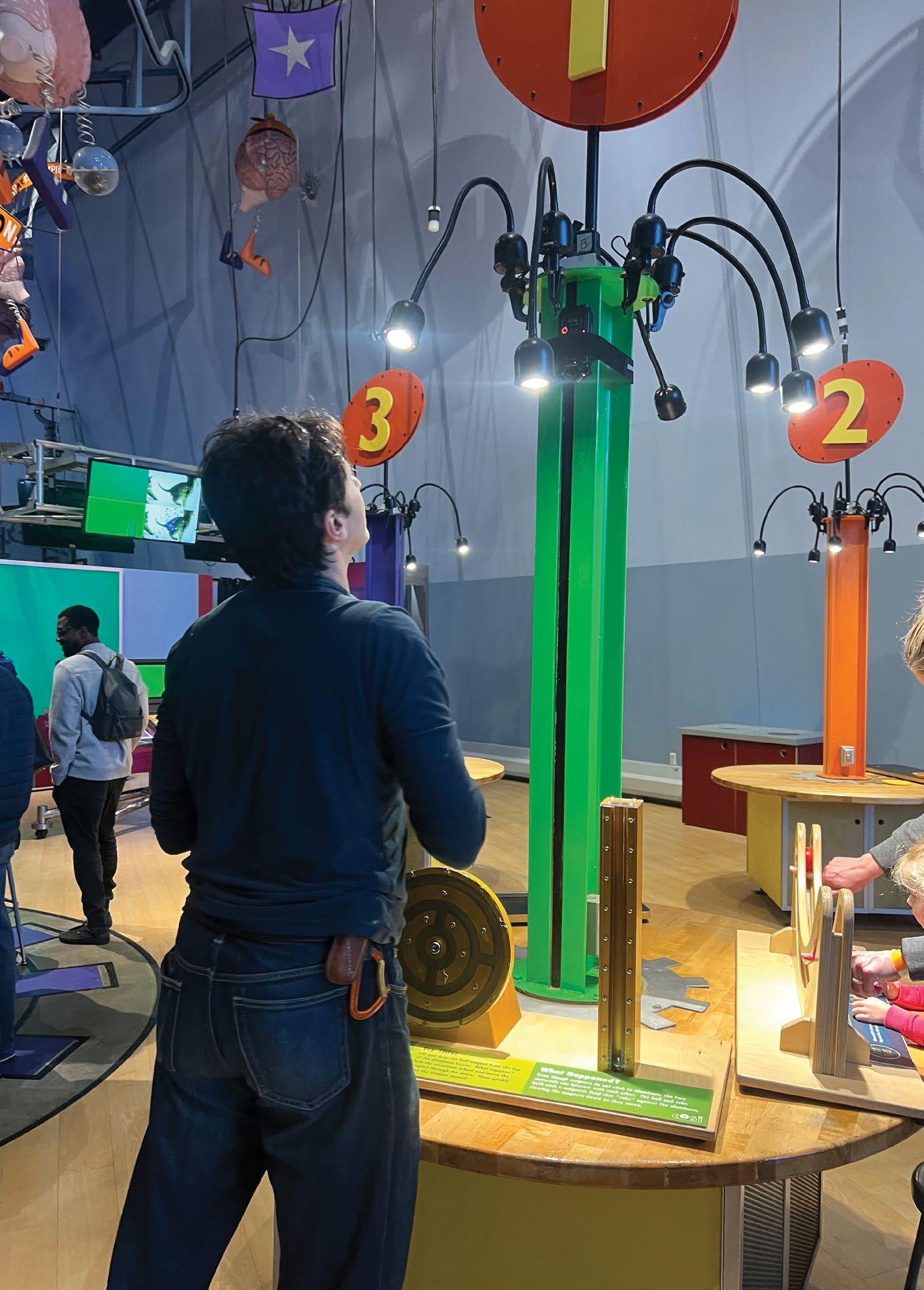

CONTENTS Letter from the President
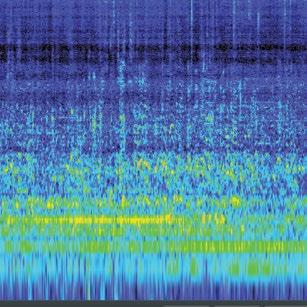
07 Discovering STEM, entrepreneurship, and careers through making .
Sound Travels
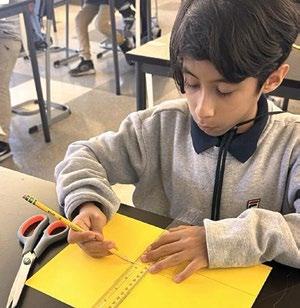
Seeking to understand how soundscapes in learning settings influence their visitors’ learning 11 Math and Making for Middle School Youth 16 MPACT Math and Computational Thinking Through 3D Maing

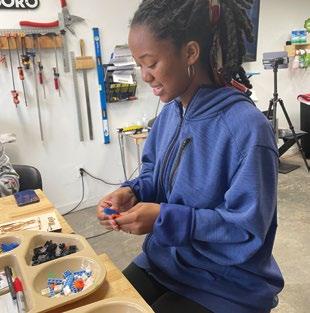
The Spring Hands On! articles take you on a journey of some informal learning research projects at TERC. First, we introduce you to new research focusing on how soundscapes in learning settings influence visitors’ learning. Then, you’ll read about our research with young learners and ‘Making’, an important medium for helping learners discover the mathematics and consequential exciting career applications as they Make.
Sound Travels is the first study of its kind, to understand how soundscapes in learning settings influence their visitors’ learning. Soundscapes are the sounds made by humans and their activity (voices, appliances,) as well as sounds from the nonhuman world (wind, water, wildlife). Desired research learning includes sounds that attract and hold the attention and lead to learning conversations. Results will inform educators and exhibit designers when they plan learning experiences.
In the African American Young Women in Making to Engage in STEM grant, 13–18 year old young Black women, through participatory design research, were engaged in making and entrepreneurship activities that emphasized STEM disciplinary practices. Their experiences included how to design, build, and pitch a product with guidance from designers, makers, STEM educators, and entrepreneurs.
In Math and Making for Middle School Youth, the experience of just one of the hundreds of students participating across California is featured. See how his journey changed how he expressed his ideas and learning in measurement, problem solving, and possible career opportunities. Youth engage in design-and-making projects that address community goals endeavoring for changes in their relationship with mathematics.
Laurie Brennan, President

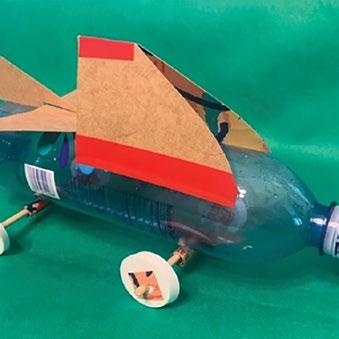
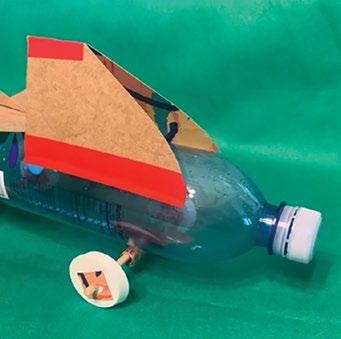
Editor: Valerie Martin
Copyeditor: Margo Miller
Administrative Support: Katie McGrath
Design: Jason Fairchild, Truesdale Group
Sr. Director of Brand Strategy & Communication: Jaclyn Parks
Hands On! is published semi-annually by TERC, a non-profit education research and development organization dedicated to building futures for all learners through STEM education and teaching.
Copyright © 2025 TERC. All rights reserved. No part of this publication may be reproduced without written permission. Email: communications@terc.edu. Hands On! is available at www.terc.edu.
All opinions, findings, conclusions, and recommendations expressed herein are those of the authors and do not necessarily reflect the views of the funding agencies.
Sound Travels Sound Travels Sound Travels Sound Travels
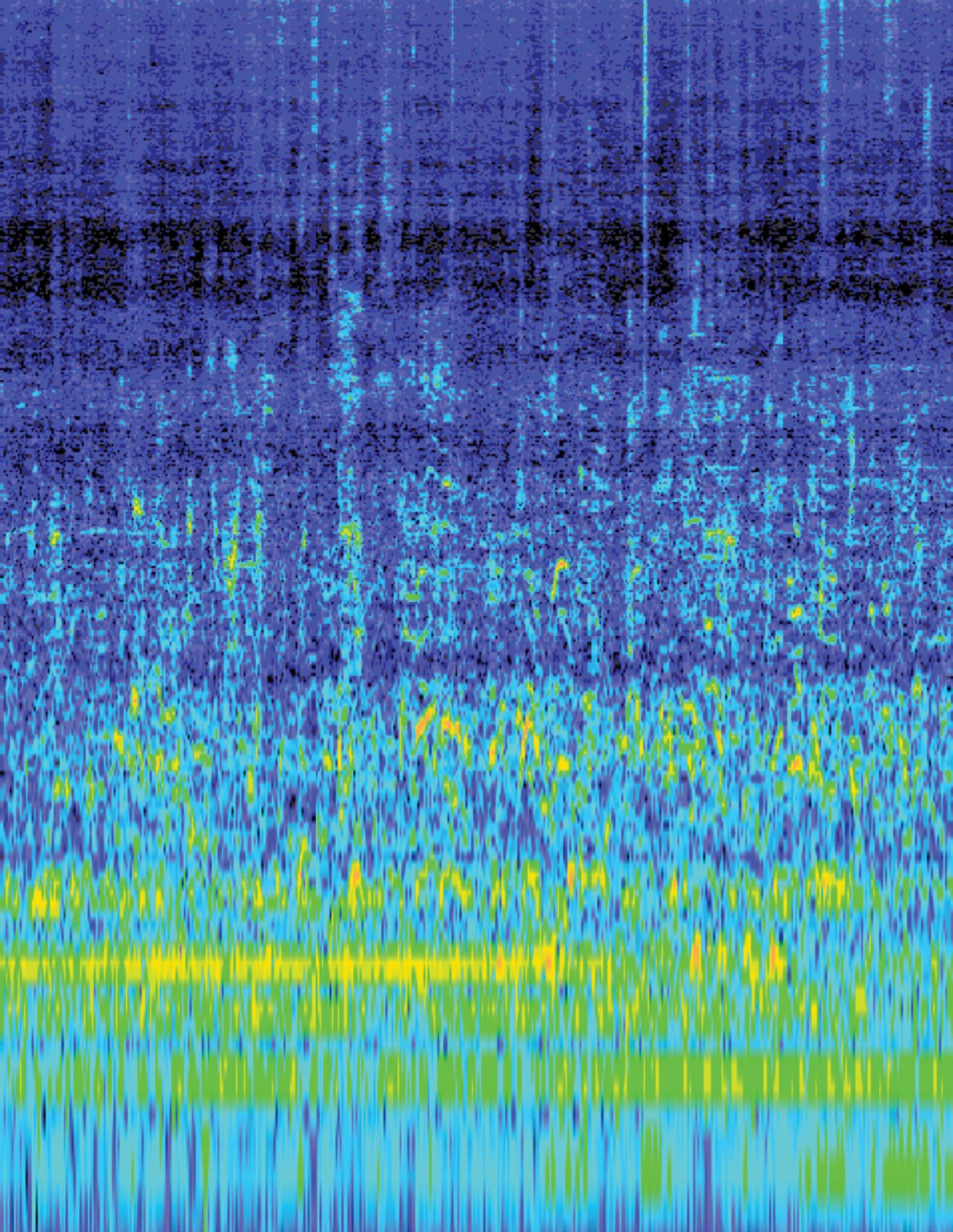
As you step into the Gadgets exhibit area at the Center of Science and Industry (COSI) in Columbus, a symphony of sounds surrounds you. The rhythmic clangs of gears, the sharp chime of bells, and the whir of unseen machines fill the space and your ears. “It feels like you’re walking into a bustling factory,” musicologist Daniel Shanahan observes. As you explore COSI, you’ll notice how the soundscape shifts from one exhibit to the next. The clangs and lively hum of human voices — excited chatter, bursts of laughter, and the gasp of discovery — might enhance visitors’ experience or detract from opportunities to learn.
Sound Travels researchers and their partners seek to understand how soundscapes in learning settings like COSI influence their visitors’ learning. Can visitors hear themselves think? Do they feel so self-conscious in a quiet environment that they hold back thoughts and laughter? Answering these questions has taken a team of learning scientists, artists, and environmental educators on a journey to define, describe, and distill patterns in the visitor experience.
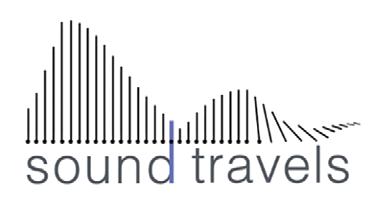
By soundscapes, we mean the sounds made by humans and their activity (appliances and vehicles), and as well as the sounds from the nonhuman world, (wind, water, and wildlife.)
Affecting the soundscape
Billy Mark, a project partner and sound artist, explains, “Every day as individuals we orchestrate a sound experience for ourselves. We choose to walk toward a soft speaker or away from noisy construction. We choose news or music. We choose headphones or not. We have sonic agency.”
Mark’s explanation of sonic agency is one of the foundational ideas about sound that has informed the project. As project partners and researchers have tuned into sound, we have a heightened awareness of these truths about sound:
ĉ In our daily lives, sound is immersive, and its sources are all around us.
ĉ Our decisions, big and small, play a role in constructing our shared sonic environment.
ĉ Sounds that help one person focus may be distracting or deeply annoying to another; sound is subjective.
Project partners are environmental educators and other practitioners with a keen ear to maximizing learning in out-of-school settings. To investigate the soundscapes that visitors encounter at COSI, parks, botanic gardens, and zoos where informal learning occurs, researchers are recording and analyzing sound clips with objective measures and asking visitors for their impressions. The research team is particularly interested in sounds that attract and hold attention and lead to learning conversations. The foundational
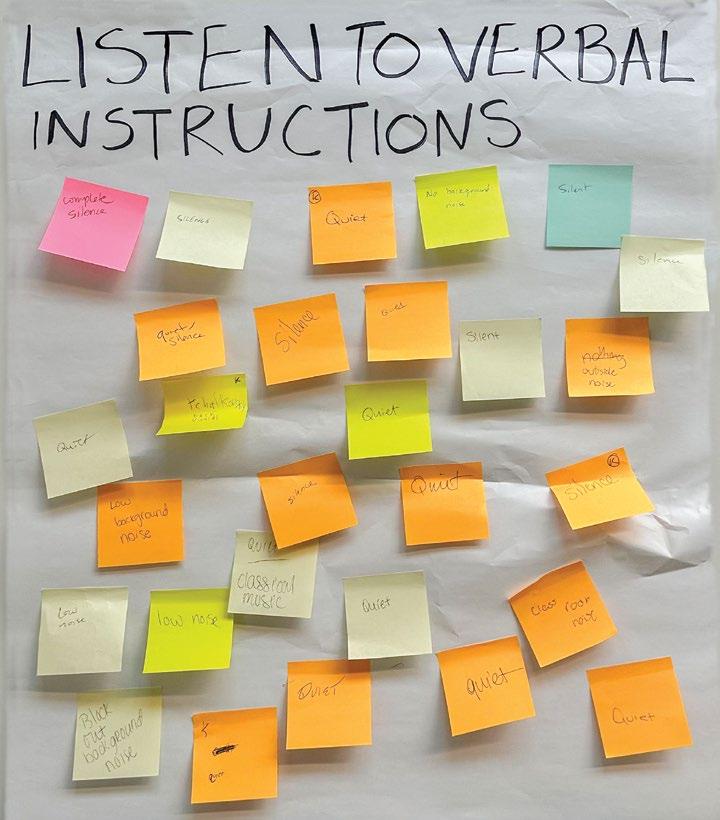
knowledge the project generates will inform educators and exhibit designers when they plan learning experiences in outof-school settings.
Shanahan and his co-PIs, Justin Meyer and Martha Merson, meet regularly with partners from informal learning institutions to ensure the research has practical applications. They also consult regularly with sound artists like Billy Mark, and sound collector Cesar Almeida. They have recently recruited four students at Massachusetts College of Art and Design (MassArt) to contribute their knowledge and expertise to their investigations.
Informal learners have opinions
Meyer, his colleagues at the Center for Research and Evaluation (CRE), and TERC researchers believe eliciting visitors’ opinions in informal spaces can be fun and lead to new insights. The first phase of visitor research focused on two exhibit areas: Gadgets (described above) and Progress, in which visitors travel through time and interact with the
technology in a town from 1898, and then turn a corner with the opportunity to explore the town and its technology as it would have looked 60 years later, in the early 1960s.
The researchers asked visitors to notice and record sounds that made them feel curious, uneasy, peaceful, or energized. The recordings with visitors’ notes are a window into the emotional impact of sounds.
Researchers also asked visitors to contribute sticky notes with their preferred sound environment for different activities such as conversations or listening to instructions. Their preferences ranged from complete silence to listening to energetic music during the activities.
During the summer of 2024, Dan Shanahan and Kim Kawaczinski of Northwestern University analyzed the recordings. Snippets of two acoustic environments are captured in the spectrograms to the right.
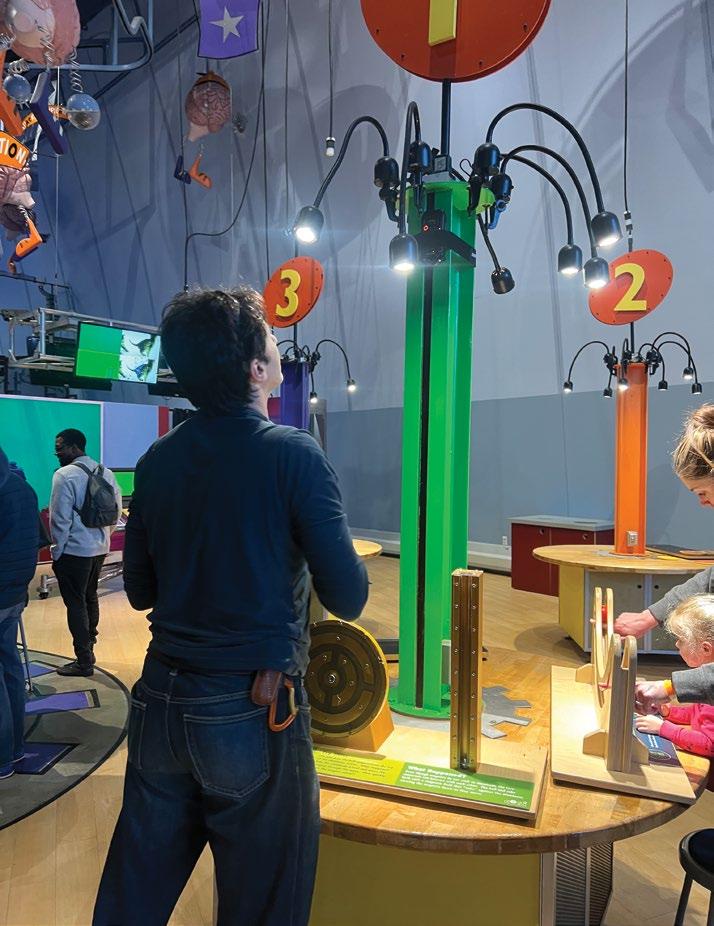
Sound Travels
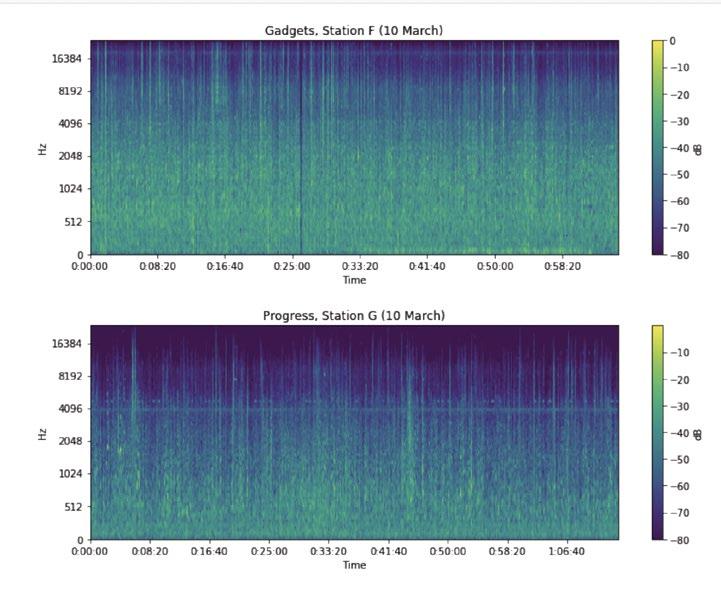
Spectrograms give a visual 2D form to duration, intensity, and pitch of a sound or soundscape. The recording from COSI’s Gadgets exhibit contains more high frequency content than the one from Progress — the green and yellow extend farther up the y-axis of the spectrogram. The background noise in Progress is lower pitched (lower and overall less green and yellow) and quieter relative to the speech signals present in the space.
A sound profile like the one we see for the Progress exhibit facilitates conversation. Obviously, the way the space holds or mutes sound has a significant impact on the overall sonic experience. At the same time, a noisy din becomes just that, a din, and may not be as distracting or antithetical to conversation as an environment with unpredictable sounds that stand out from the background.
Research in service to practice
At its four sites in Columbus, researchers collected an estimated 500 hours of audio recordings, 140 sound searches (visitor-driven recordings and interviews), and nearly 1000 questionnaires measuring close to 100 variables. Merson noted, “As the first study of its kind, we felt looking at dozens of variables made sense — where visitors grew up, their cultural and religious practices, and affinity/identity with respect to music could all have an impact on how sensitive or oblivious they are to soundscapes in informal learning settings.” With such an extensive data set, the research team planned an activity to solicit input on priorities for data analysis.
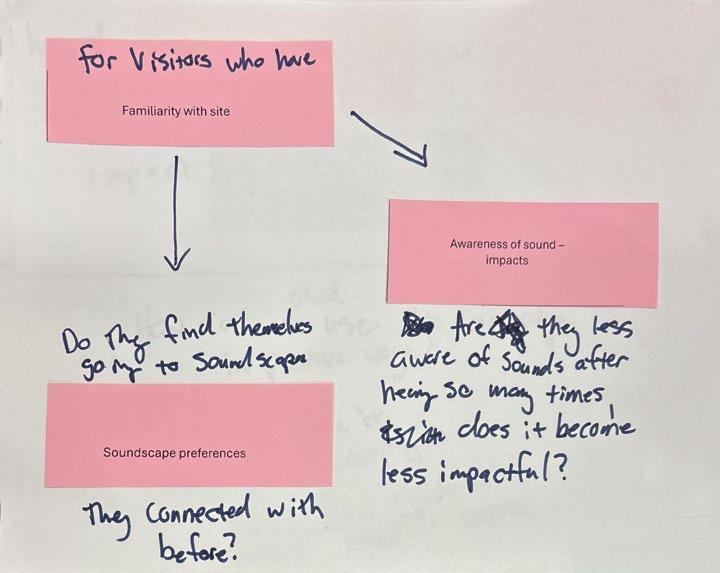
Meyer, and the CRE team, Hayde, Weiss, and Heimlich devised the plan. They gave project partners 18 color-coded cards labeled with the different types of data collected through each method (i.e., Sound Searches, visitor questionnaires, and audio recordings).
Meyer says, “We found 60 relationship pairs that warrant consideration. We also noted interest in sonic literacy, mental health, and sense of connectedness as they relate to sound and soundscapes, so these topics will become part of data collection in 2025.”
The research is still unfolding, but some early findings are intriguing.
In the sound search data, visitors rarely selected and labeled human sounds as peaceful. They rarely identified programmed sounds as energizing. They rarely identified biogenic sounds like water or birdsong as making them feel uneasy. The data suggest that designers can predict how a certain sound will not affect visitors. For example, if educators or exhibit designers want to create a peaceful sound environment, the data indicate they should steer away from human sounds. If they want to create an environment that makes visitors feel uneasy, biogenic sounds visitors identified and collected would not evoke that reaction. Biogenic sounds would not have a singular effect. For some visitors they were energizing, for others calming.
Finding relationships between sound preferences and upbringing, relationship to music, and cultural background
has proven trickier. Thus far, we haven’t seen a strong positive relationship between preferred sound environments for different activities, like having a conversation or listening to verbal instructions, and cultural background. We do see a striking pattern emerging — visitors indicated they heard sounds that helped them reflect on things they were learning. Regardless of their expectations of the sound environment or their reasons for visiting an informal science learning site, the sounds stand out as a predictor of higher learning indicators.
Identifying sounds that help visitors reflect and report learning outcomes may prove easier than identifying sounds that evoke a particular emotional response.
Sound for the Visitor Experience
Matt Renfree directs the North Park Village Nature Center, a cherished neighborhood open space in the North Park Village neighborhood of Chicago, which has hosted numerous sound walks and citizen science research on singing insects. The space was once part of a public health sanitarium and retains a distinctly sterile feeling. Renfree envisions a responsive sound environment that pairs well with a nature center visit experience.
With Sound Travels advisor, Cesar Almeida, musicologist Dan Shanahan and other advisors, he expects to produce and queue up seasonal soundtracks that mirror the day’s weather conditions, enriching visitors’ sonic experience of the
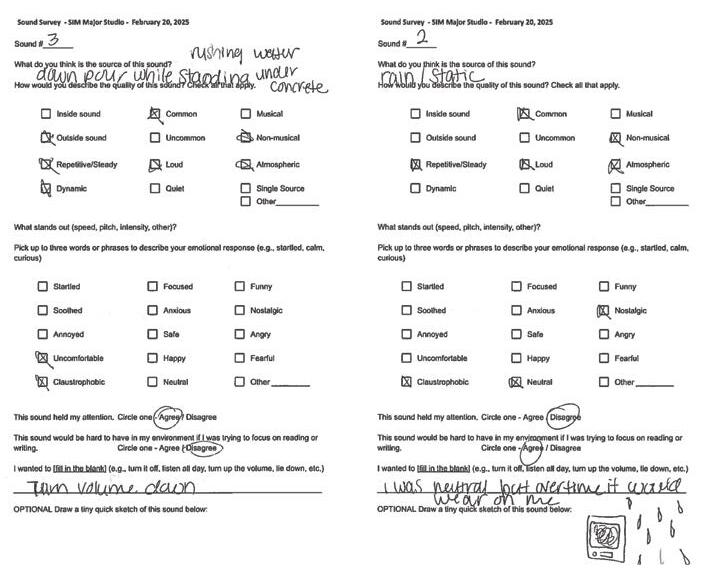
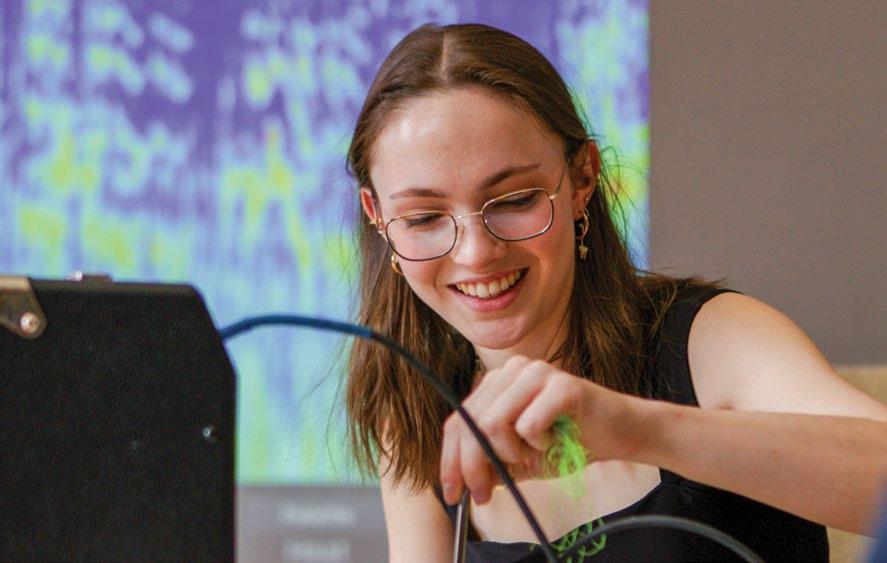
visitor center. In order to maximize enjoyment and learning outcomes from the exhibits, Matt and Dan will leverage findings from the questionnaires and sound searches.
Four MassArt students and the department chair of the Studio for Interrelated Media joined the project in 2025. Each of the students has an interest in using sound in immersive experiences and they’ve been excited to add a research component to their practice. In February, they devised their first round of data collection. After introducing the Sound Travels project, they asked 50 of their peers to describe 12 sounds and then record their emotional reactions. They also asked for a self-report on whether sounds like a fan, bubbling waterfall, or people at a festival in their environment would make it hard to focus on reading and writing.
The project’s research team is excited about the interdisciplinary explorations that have great potential to inform learning design. The research team has plans for further analysis and data collection in 2025. In 2026 partners and researchers will communicate findings to informal educators. All look forward to sharing the results of sound artist collaborators’ experiments.
terc.edu/soundtravels
Sound Travels
Learn more about Sound Travels site visits:
Greetings from Detroit blog.terc.edu/sound-travelsgreetings-from-detroit
Exploring the Unique Soundscape of North Park blog.terc.edu/sound-travelsexploring-the-uniquesoundscape-of-north-park
Greetings from Columbus, Ohio blog.terc.edu/sound-travelscolumbus-ohio
CONTRIBUTORS
Justin R. Meyer, Kimberly Kawczinski, Elise Levin-Güracar, Billy Mark, and Martha Merson contributed to this article. Along with Sound Travels researcher colleagues Daniel Shanahan at Northwestern University, Nickolay Hristov at TERC, Joe E. Heimlich, Laura Weiss, and Dolly Hayde at COSI’s Center for Research and Evaluation (CRE), they are grateful to institutional partners including the Franklin Park Conservatory, The Columbus Zoo, MetroParks, the North Park Village Nature Center, Solidarity Studios, Wild Indigo of Audubon Great Lakes, and the Neighborhood Art School in Detroit.
Research to Understand and Inform the Impacts of Ambient and Designed Sound on Informal STEM Learning (Sound Travels) is made possible with support from the National Science Foundation DRL2215101 Any opinions, findings, and conclusions or recommendations expressed in this material are those of the authors and do not necessarily reflect the views of the National Science Foundation.
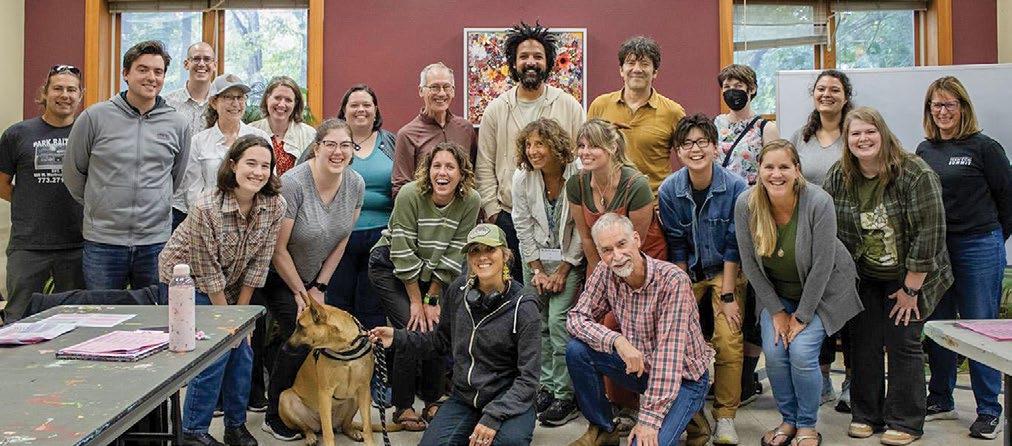
Making and STEM Learning in Formal and Informal Settings
Our research from multiple projects shows that making-based learning can effectively help students explore real-life situations where math and other STEM subjects are useful and important. Over the last 10 years, our team has explored the affordances and drawbacks of making in schools, afterschool programs, and informal learning settings as well as with different age groups, from students in 4th grade all the way to high school. In collaboration with partners and teachers, we have tested 3D design and 3D printing in math classes to elevate spatial reasoning. We have also worked to support youth in connecting STEM and entrepreneurship through making in a makerspace. And, finally, we have created a math and making afterschool program that provides real-world contexts and tools to solidify and expand youths’ service to their families and communities. In short, we have found that makingbased learning has allowed us to engage students who may otherwise be uninterested in STEM subjects and allowed us to more deeply engage even those learners who already enjoy STEM.
What is Making?
Making is the set of activities that people engage in to conceptualize, design, craft, and build objects both physical and not. Making disciplines include ceramics, woodworking, tinkering, textile arts, computer-aided design and many others.
Our first foray into making and mathematics (MPACT, DOE # U411C180070), was the development of a set of grades 4–7 in-school curricula to promote spatial reasoning, computational thinking, and standards mathematics content. Youth were introduced to a fourphase design approach (Collect Ideas, Prototype, Design, Make) to create 3D artifacts. They collected ideas on solving a particular design problem through observations, interviews, and research. They created prototypes with easy-to-obtain reusable materials, like cardboard and masking tape, and then generated designs in TinkerCad™, a freely available 3D design program suitable for school-age students. Students then printed their designs and compared them to their design goals. We found that youth developed a more robust understanding of key
Learn More
AAMASE Website terc.edu/projects/aamase
AMPED 4 Making Website terc.edu/amped4making/
Making an Impact with MPACT terc.edu/hands-on-magazine-fall-2023
MPACT Website terc.edu/projects/mpact
Making in the Garden terc.edu/news/math-and-making-fccenters
mathematics and improved their spatial reasoning.
Through a propitious collaboration, we designed AAMASE, an out-ofschool project to explore in more detail the possibility of older youth learning STEM and entrepreneurship through making in a wellestablished makerspace (AAMASE, NSF#2148543). The groups of mostly young women worked in collaboration with local professional makers, developing their agency and making skills. Being in the makerspace, youth were able to participate in consequential making–the kind of making that is meaningful to the youth, resulting in a useful and/or beautiful object (Tan et. al, 2016). These young women engaged in welding, resin casting, laser cutting, wood-working, ceramics, sewing, and electronics among other making activities. You will see examples of several youths’ experiences in the AAMASE article in this issue.
Our third project, AMPED 4 Making, (NSF#2215382) was codeveloped with the Cesar Chavez Foundation to explore the intersection of consequential making and mathematics in afterschool settings. The goal is to engage middle schoolers in design-and-making projects to address community needs as perceived by the youth. In the four semesters, youth use mathematics to design, prototype, or build meaningful and useful artifacts. Throughout they learn about and embody principles derived from the life of Cesar Chavez, such as service-orientation, appreciation of their communities, and development of persistence, which the program and youth also know as “Sí Se Puede” (“can do” or “yes we can”) attitude. In student interviews (page 12), youth show us what they have learned and how proud they are of what they make and what they have learned while making.
Finally, our newest venture, Making in the Garden (TERC-funded) examines how making and playing with human-sized geometric objects in an afterschool setting, with young children ages 9-11, impacts their spatial reasoning and mathematical thinking. These activities have had extremely high engagement from youth and facilitators, and have resulted in a 3D making club led by program teachers. We expect to share stories and findings in future issues of Hands On!
References Tan, E., Calabrese Barton, A., Shin, M., & Turner, C. (2016). Probing participatory partnerships: Equitably-consequential making by, for and with marginalized youth. Proceedings of the 6th Annual Conference on Creativity and Fabrication in Education.
Acknowledgements
This material is based upon work partially supported by the National Science Foundation Awards #2215382, #2148543 and Department of Education award # U411C180070. Any opinions, findings, and conclusions or recommendations expressed in this material are those of the author(s) and do not necessarily reflect the views of the National Science Foundation or the Department of Education.
Authors Teresa Lara-Meloy and Ken Rafanan are PIs on AMPED 4 Making and AAMASE, respectively. They also collaborated in MPACT and Making in the Garden.
“The girls have become more future minded.”
—NURIA JAUMOT-PASCUAL, ELISE LEVIN-GURACAR, KEN RAFANAN
Discovering STEM, entrepreneurship, and careers through making
DR. NURIA JAUMOT-PASCUAL, PH.D.
ELISE LEVIN-GÜRACAR
KEN RAFANEN
African American Young Women in Making to Engage in STEM and Entrepreneurship (AAMASE) is a National Science Foundation ITEST Developing and Testing Innovations project aimed at serving 13–18-year-old young Black women in Greensboro, NC. TERC collaborated with the Forge Greensboro, a nonprofit community makerspace.
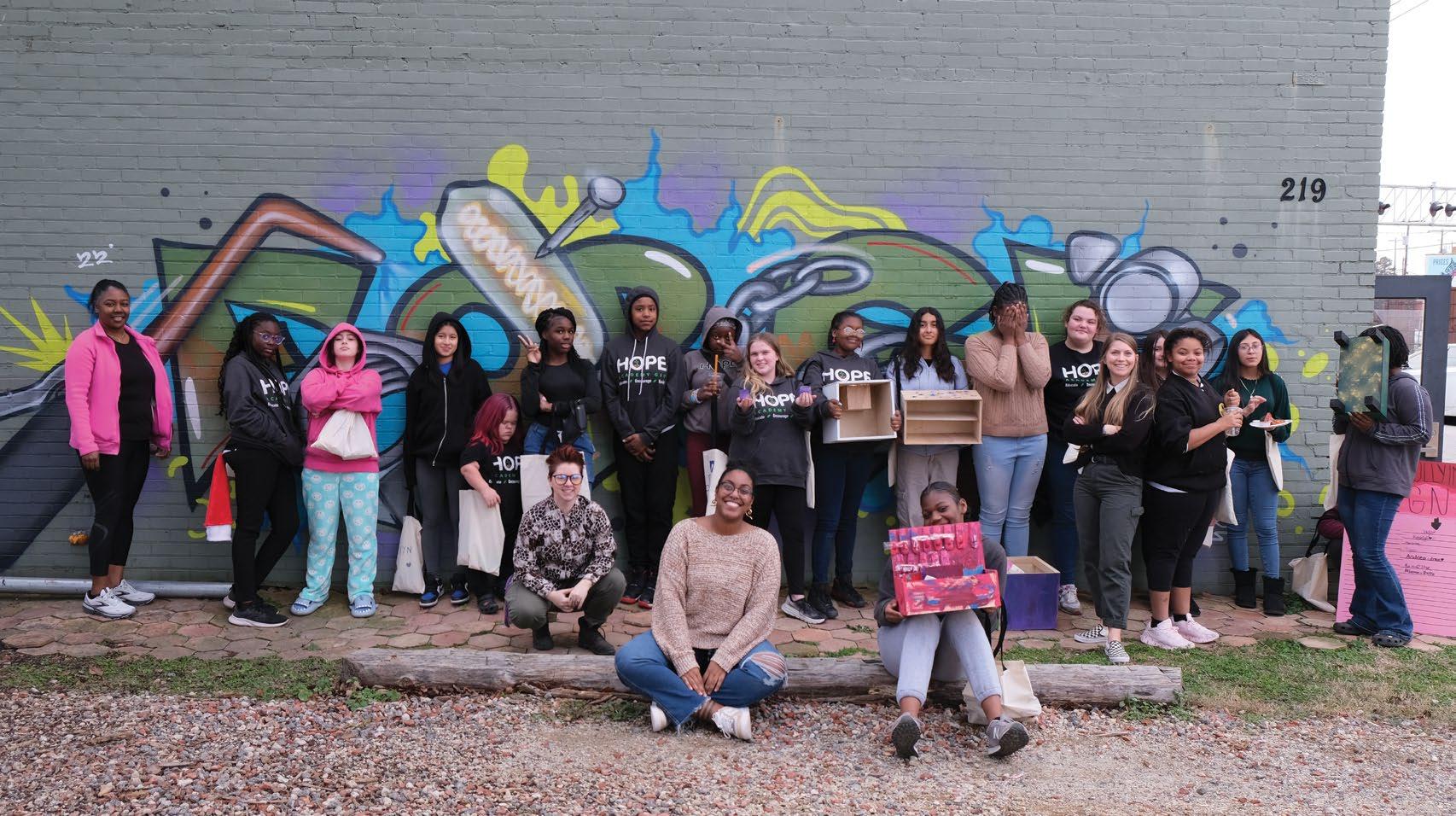
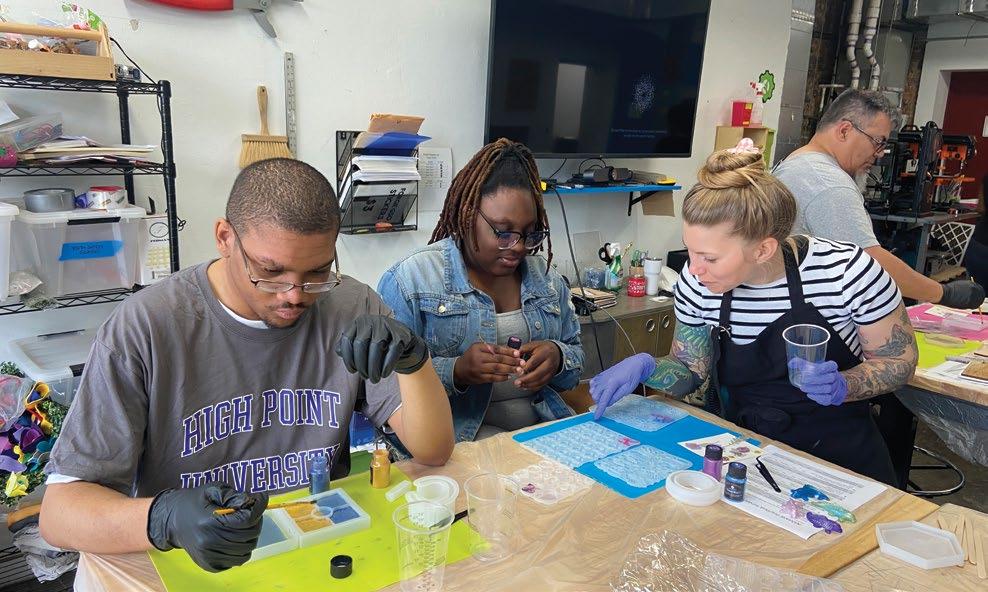
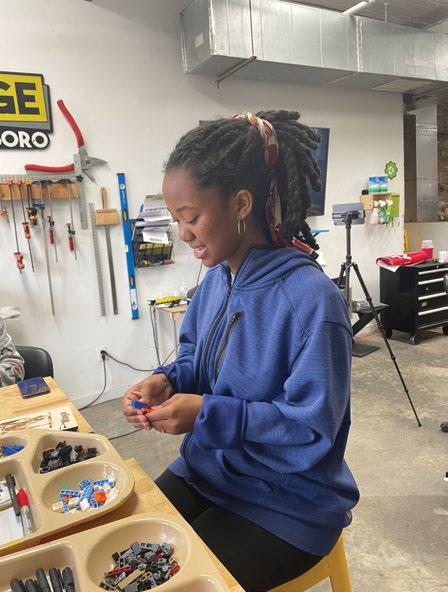
Through participatory design research, we engaged youth in making and entrepreneurship activities emphasizing STEM disciplinary practices that built their engagement and skills in STEM and their awareness of STEM career pathways. Participants learned how to design, build, and pitch a product with guidance from designers, makers, STEM educators, and entrepreneurs.
The research included interviews with partners, mentors, and facilitators; activity recordings; and interviews with the youth. The highlights below are based on data from four groups that participated in the program for 8-10 weeks. Each group had about 10 middle and high school age young women who were mostly Black or African American, but also included white, Native Hawaiian, and Latina young women.
Entrepreneurship
Dimensions of Entrepreneurship
The youth, like Vanessa, appreciated that AAMASE introduced them to the possibility of creating their own companies and selling their products: “If I do well, I can sell the stuff and build my own little company.” Some participants had a vision for their products, including the problems they would address, and their aesthetics. Nicole, for example, talked about her personalized whiteboard concept:
This is your own personal handy dandy whiteboard. But it’s different from an average whiteboard. Average whiteboards, they’re plain. They’re boring. … [This whiteboard would] be able to support your reservoir [of creativity]. It will come in any shape or size ... If you want a heart, rest assured, whatever your desire is, I will make it.
In their final presentations, participants showed awareness of the dimensions of entrepreneurship, including pricing, marketing, and materials needed, and they discussed these with different levels of comfort. One commonly omitted area was the price of labor. Youth often underestimated the time spent in making the product and the value of their time. These factors resulted in consistent underpricing of their products. It should be noted that pricing is a common challenge for new making-based businesses.
Brand Development
Many youth had precise brand visions. Some of them even planned to sell their products to their school friends. For Nicole, it was important for her brand to reflect her unique personality:
[My poster] says “I feel like a pea in my pod”. That’s basically saying “You could be surrounded by so many people, but you feel like you’re an individual person. … You can have all these friends, but you’re like a pea in a pod.” … There’s one specific pea that represents me out of my friend group. I feel like the weird one.
She wanted her products and brand to reflect her feeling of being different even when surrounded by friends. She also wanted to create idiosyncratic products. AAMASE supported young women’s creative thinking about product and brand development using the skills they learned in the program to reflect their personalities and interests.
Discovering STEM, entrepreneurship, and careers through making
Everyday Skills and Hobbies
The young women enjoyed experimenting with different materials and learning new skills in the program. For some, these were hobbies or useful abilities for everyday life. Hailey, for example, considered the program to be useful in several ways. She saw it as “A great way to see new hobbies and stuff, something that is important enough to put on a college resume” because she could show that she had skills, like wood carving, and that she could use tools. She also found it valuable that she could use those skills to help people and to save money because she learned “to make things so you’re not paying someone else.”
Similarly, multiple youth talked about sewing and pottery as skills to save money and help others. Vanessa pointed out that “Instead of shopping, I can just make my own clothes and build my own plates and bowls.” Hannah mentioned how pottery skills would allow her to make a flowerpot for her grandmother and learning to use a sewing machine would allow her to make herself clothes. Niarra and Blair also talked about using their newly-acquired sewing skills to fix ripped clothes for themselves, family, and friends.
Careers
Partners and mentors pointed out that participating in AAMASE provided youth with career alternatives that they had not previously considered, particularly entrepreneurship
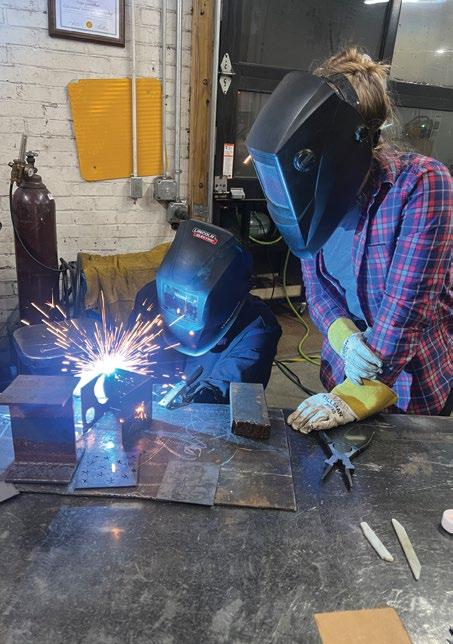
and specific making disciplines. Daisy, a mentor, emphasized that youth could take what they learned in AAMASE in multiple directions: creating a business, learning a skill or trade, establishing a career, or simply doing something fun. Daisy noted, “that’s how AAMASE feels to me, we give them a chance to do a thing that they might not have ever had a chance to do.” Margot, another mentor, talked about how AAMASE sparked ideas for two participants’ gap years:
There are a couple of seniors who are deciding to take a gap year, and because of this class and listening to some of the things that [the AAMASE facilitator] had said and some of the projects that they’ve done, they’re looking to try to grow some businesses out of that during the summer in their gap year. Evan, one of the partners who brought youth to the program, emphasized that the young women who participated in AAMASE developed relationships with program staff, learned about STEM career options, and became “more future oriented”:
The girls in our program have ... become more futureminded. [Serena] is there because she loves anything women’s empowerment and girls’ empowerment. She’s huge about girls doing anything that anyone else is doing. She has just fallen in love with the program. It is one of her favorite things that she does. She lights up. She has to be there.
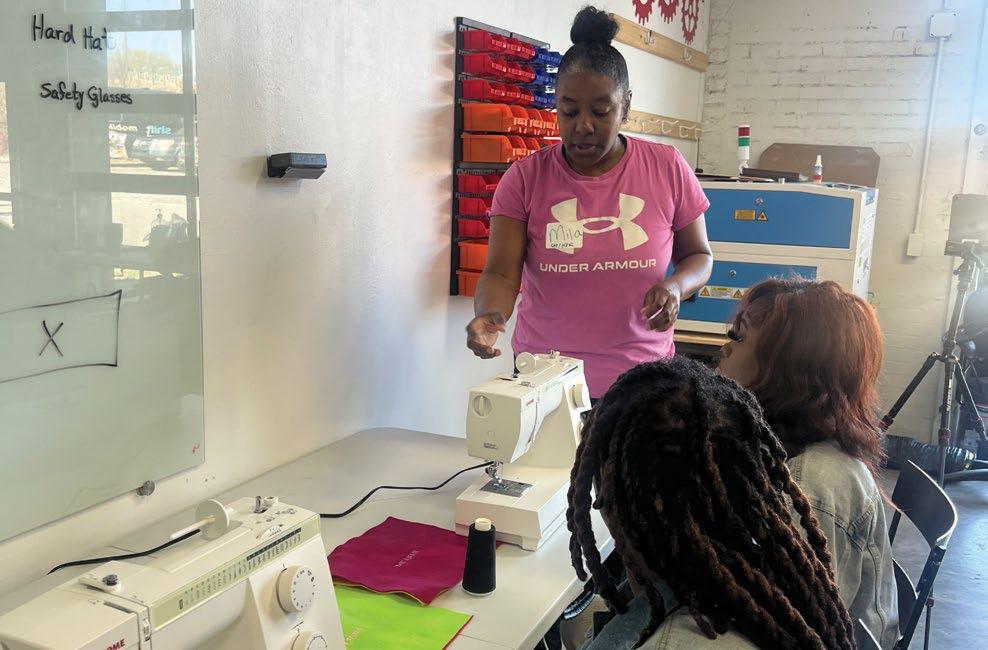
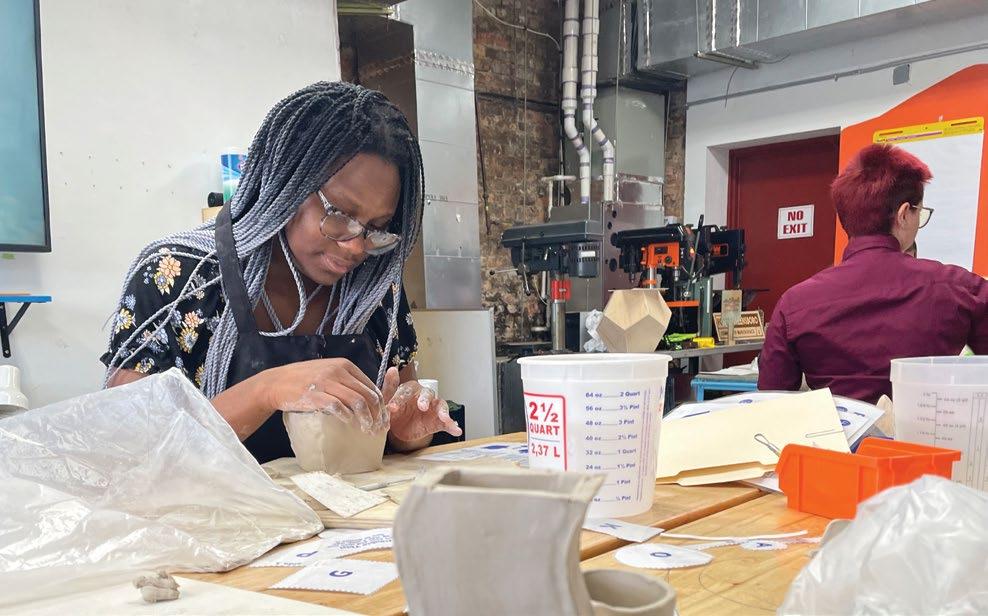
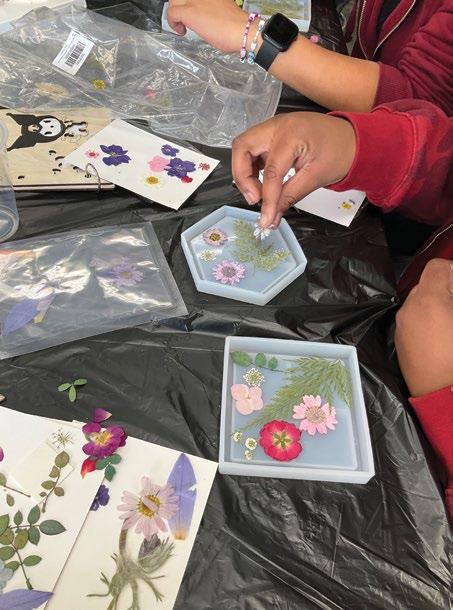
Serena shared that she wanted a career working in a similar program, facilitating activities for young women. She already worked with children, so AAMASE provided her with a view of a related career path involving STEM and making.
The opportunity to experience making disciplines that they would not usually be exposed to such as metalwork and woodwork, presented young women new potential career options. Morgan and other youths shared that metalworking used to seem scary, but that trying it through AAMASE turned it into something empowering and fun:
I’ve always wanted to be an artist. My dream has been to be a children’s book writer and to draw my own or paint my own illustrations. Either that or in metalworking. That’s something that I think is just really interesting and it can be a really sustainable job. I definitely do see myself being able to have a job with this.
Morgan found that metalwork gave her self-confidence, leading her to now consider it a viable career choice.
Conclusions
AAMASE presented young women in the program with an array of skills that allowed them to be engaged in enjoyable and productive activities. Some of these skills were potential hobbies or everyday skills while others allowed them to explore careers that they would not have learned about otherwise and that they found empowering.
To learn more, visit the AAMASE website terc.edu/projects/aamase
Authors
Dr. Nuria Jaumot-Pascual, Ph.D., is a Research Scientist at TERC. She researches the experiences in STEM education and careers of populations that live at the intersection of interlocking marginalities, with an emphasis on gender and race/ethnicity. She currently coleads several National Science Foundation–funded projects. Two of them use participatory and co-design methods to bring STEM and making to youth from groups that experience marginalization. She is also co-PI of two studies on the experiences of Native students and professionals in STEM and of a project that brings qualitative meta-synthesis methods to scholars focusing on equity in STEM. Dr. Jaumot-Pascual is a member of the research advisory board for the ADVANCE Resource and Coordination (ARC) Network. She specializes in qualitative, literature synthesis, and visual inquiry methods and holds a doctorate in Qualitative Research and Evaluation Methodologies from the University of Georgia.
Elise Levin-Güracar is a math educator and researcher at TERC. She is on the design and research team for AAMASE. She studied education, public policy, and sociology at the University of California at Berkeley, and received her secondary math teaching credential after student teaching with a 7th-grade class. She continues to teach math to third- through eleventh-graders. As a maker, she enjoys gardening, playing with acrylic paint, and learning new crafts (most recently ceramics and water marbling).
Ken Rafanan is a Senior Education Researcher at TERC. He develops learning activity systems integrating teacher professional development, curriculum, assessment, and technology designed to develop learners’ agency and enhance learning of STEM disciplines. Ken’s recent work has focused on the use of making to support learning for students in and out of school. In addition to leading the AAMASE project, Ken is a co-PI on a National Science Foundation Advancing Informal STEM Learning funded research project to develop and research an after-school program designed to engage rural, Latinx youth in design thinking and math through making. Ken is an avid maker with a focus on ceramics.
“It’s very important to have measurement be precise to get things the way you want.”
Math and Making for Middle School Youth
DR. NURIA JAUMOT-PASCUAL, PH.D.
ELISE LEVIN-GÜRACAR
TERESA LARA-MELOY
VANESSA GALEANA
In an afterschool program in a small city in California, Carlos*, a MexicanAmerican middle schooler, uses scissors to cut out two congruent pieces of felt to make a Mexican flag plushie to represent his family’s heritage.
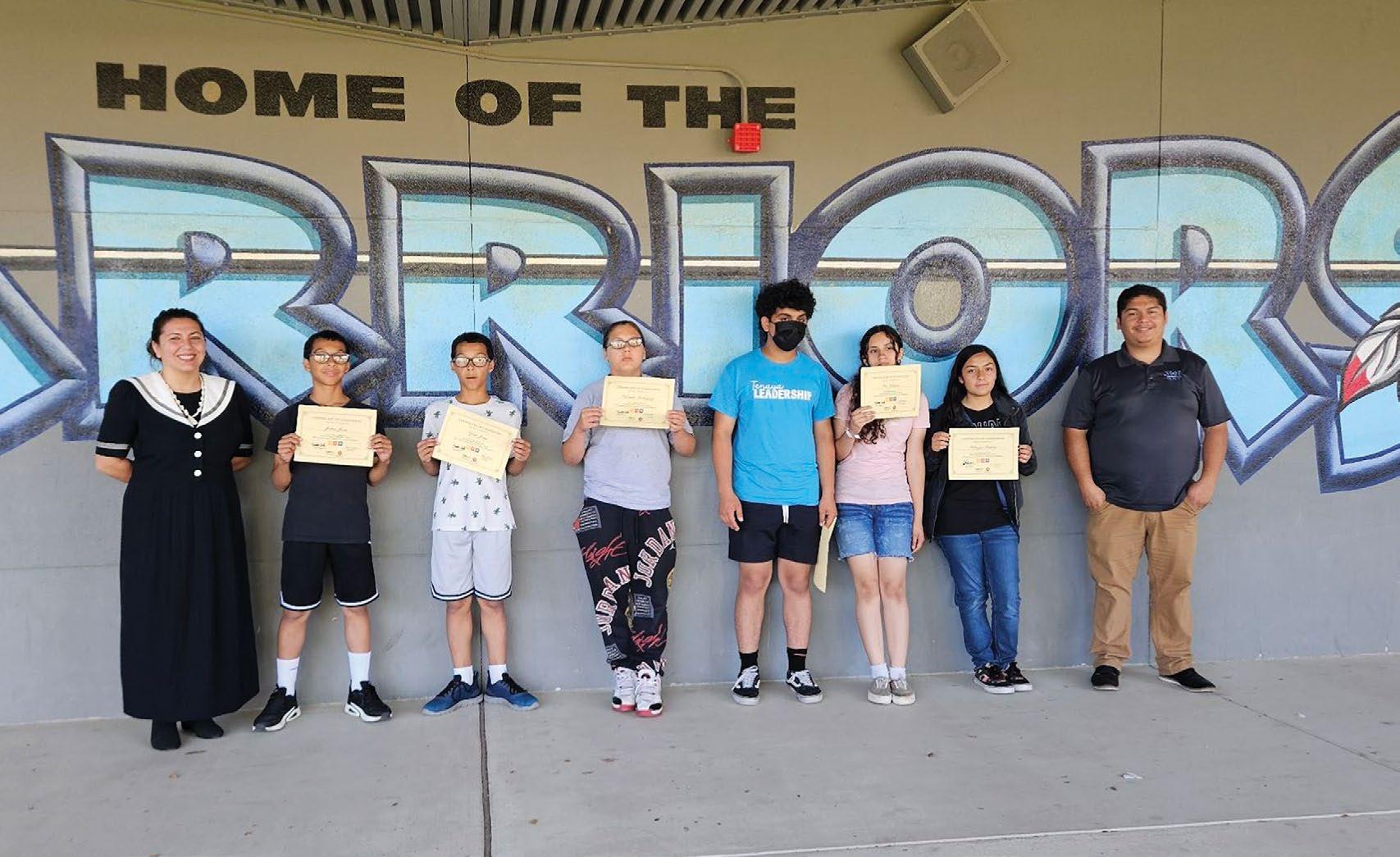
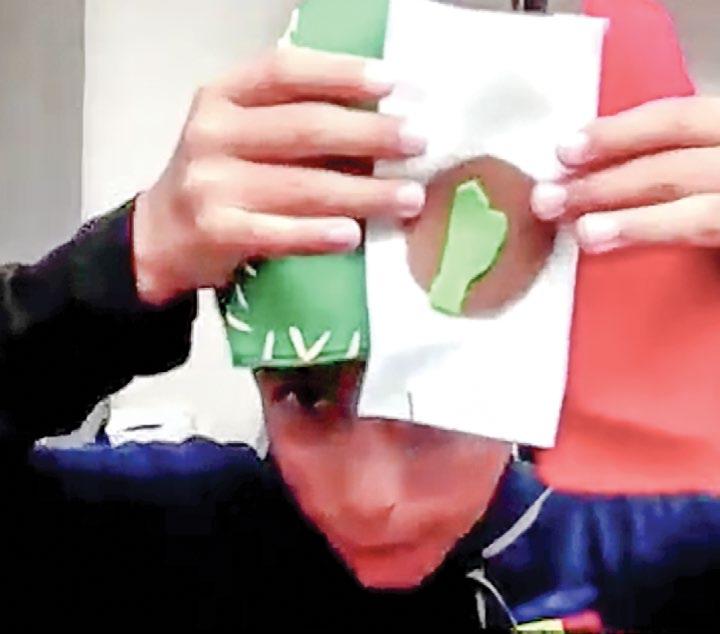
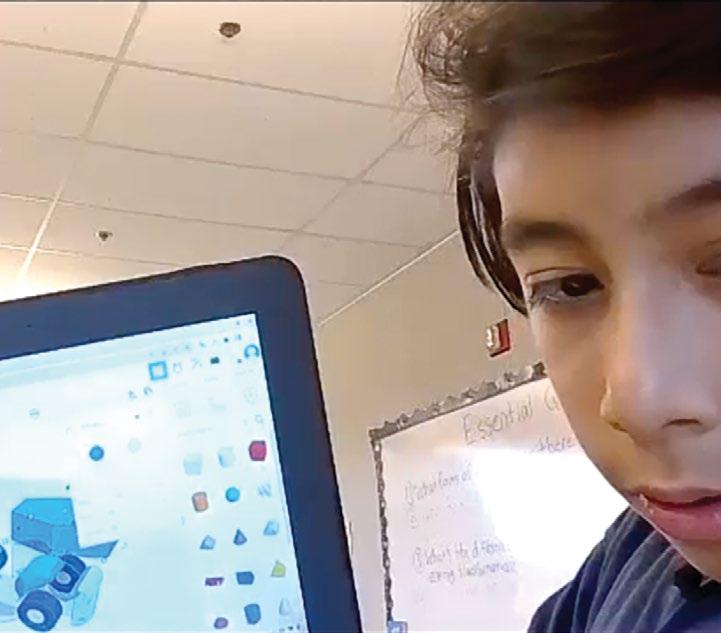
As he showcases his final plushie that includes LED lights (Figure 1), Carlos tells us how important measurement has been to his process. Carlos is one of over 200 hundred middle school children across California participating in AMPED 4 Making, an NSF-funded project (NSF-2215382) co-designed by TERC and the Cesar Chavez Foundation (CCF) Education Fund.
The Cesar Chavez Foundation is committed to serving the long-term needs of Latinos and working families. The Foundation’s mission is to carry on Cesar’s life’s work of uplifting the lives of Latinos and working families by inspiring and transforming communities through social enterprises that address essential human, cultural, and community needs.
In AMPED 4 Making, middle school youth engage in designand-making projects that address community goals aiming for changes in their relationship with mathematics. In each project, youth use mathematics to design, prototype, or build meaningful and useful artifacts. AMPED 4 Making relies on the life and values of Cesar Chavez as a touchstone for Latinx youth’s positive identity.

Research Methods and Object Elicitation
Part of AMPED 4 Making’s goals is to understand how the activities developed by middle school youth work when facilitators and youth use them. The research includes a youth survey, a math learning assessment, interviews with facilitators, and object elicitation interviews with the youth. Object elicitation (Levin-Güracar et al., 2024) is a data collection method that centers the youth participating in the program in an interview around an object that they made in AMPED 4 Making. Since the objects were created by the participants, the objects embody their knowledge, skills, and attitudes and make interviews easier by shifting the focus of attention from the interviewer-interviewee dyad to the object. This type of interview elicits richer information than regular interviews because images and objects facilitate recalling processes and memories in more detail (Harper, 2002).
This longitudinal single-case study (Yin, 2003) looks at the changes experienced by Carlos over the course of his participation in AMPED 4 Making in 2023–2024. We detail the changes in how Carlos expressed his ideas and learning in three areas: measuring and other math, careers, and problem solving through two end-of-semester object elicitation interviews (November 2023 & May 2024). In the first interview, Carlos showcased a car figurine he made on Tinkercad (Figure 2). Later, in the second interview, Carlos showcased multiple projects, including an unfinished flag plushie (Figure 1).
Math: Importance of Measuring
Carlos demonstrated a growing sophistication in the way he discussed the math embedded in the making projects. When discussing the car figurine in the first interview, he talked about sizes but did not identify lengthening and shortening as being related to math or measurement:
“An object will depend on size. And when you vision objects, not in math, but the object when you sculpt or make it … you will have to try to shorten the length of the main and give more space to the thing that you desire most and want to add.”
Though he explained that shortening one of the dimensions would provide more space in Tinkercad to other dimensions of the figurine, he did not consider it to be math. By the second interview, he clearly articulated the need for precision in measurement in order to accomplish the desired result:
“Well, one of the very first things I learned actually was about measurements, and how it’s very important to have these to be precise to get things the way you want.”
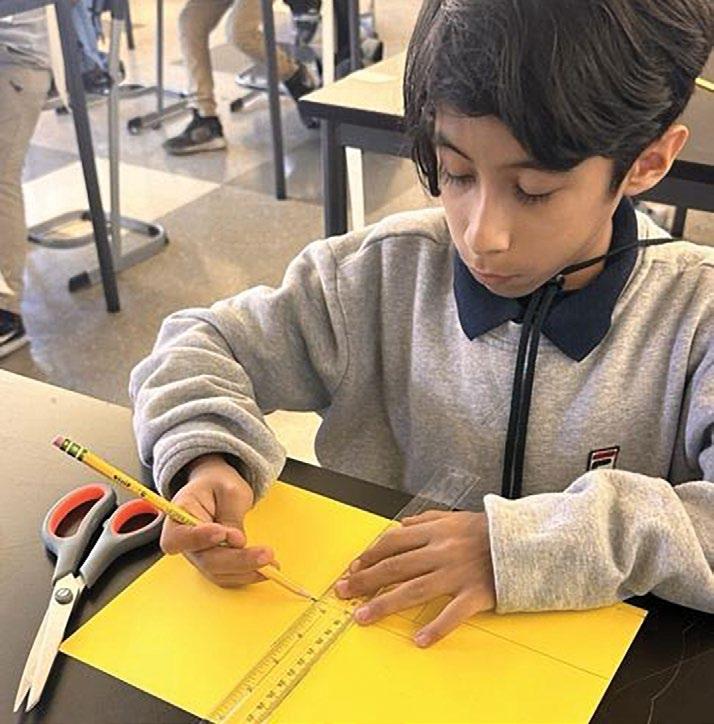
Between the two interviews, Carlos had many opportunities in the program to practice with measurement (Figure 3) and experience what happens when measurements are not accurate, and he was able to express the importance of precision.
Future/Careers: Skills Learned and Career Paths
One of the goals of the program is to expose students to skills that they could use in their future careers. Carlos demonstrated interest in career paths that he hadn’t considered before. Through the program, he explored ways to use his newly-learned skills in math and making. When asked in his second interview about how the skills he learned in the program might be useful for a job, Carlos noted three different careers that he could potentially pursue with his new learning:
“One of them would be a professor, for example, in mathematics, which obviously is very good, because they taught us those skills, and also a coder, for example, with software, which they also taught, or hardware. The clay or a potterist [sic] is really helpful to learn about these skills. … I have some ideas about jobs, but I never got the actual experience like that this [program] gave me.”
Along with the three careers, he mentioned important skills he learned such as teamwork, cooperation, and a willingness to do what may be necessary for a task, volunteering that these would be valuable in future work:
“In terms of teamwork, and cooperation, I felt like that was really good for us. Because it’s a very important skill that you need when you get a job. And also, in terms of other skills, it’s very important to get hands on work to not be afraid to get dirty or be afraid of really anything, and it really helped us gain confidence.”
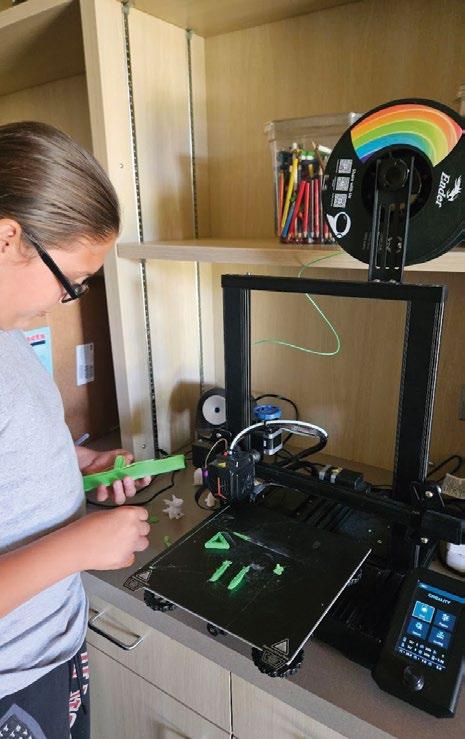
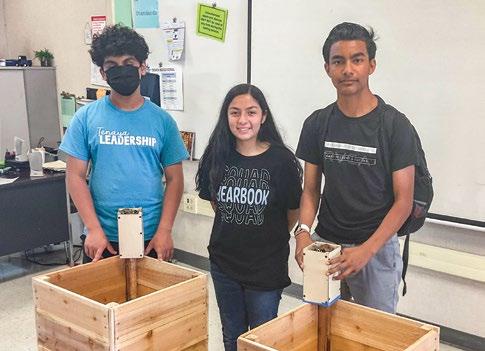
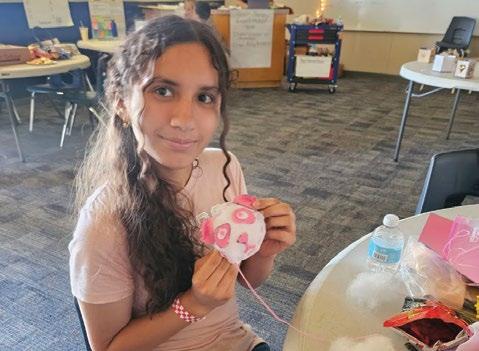
The three specific careers that Carlos expressed interest in are all aligned with skills learned through AMPD 4 Making. He has made a valuable connection between identifying career skills and his future.
Problem Solving
Carlos showed that he developed skills such as troubleshooting in his work with the various projects he did in the program. In the first interview, he had a hard time explaining the difficulties that he ran into when making a car model on Tinkercad:
“Well, the bumper wasn’t exactly how I imagined it, I guess, but I did—I was able to, how do you say it—I was able to successfully. I was able to successfully take the—I kind of imagined the bumper as this and then the final part of above.”
In his halting speech, he tried to explain that the bumper was not turning out the way he envisioned it. In his second interview, he eloquently explained that through participation in the program he developed his problem-solving skills through the use of 3D modeling:
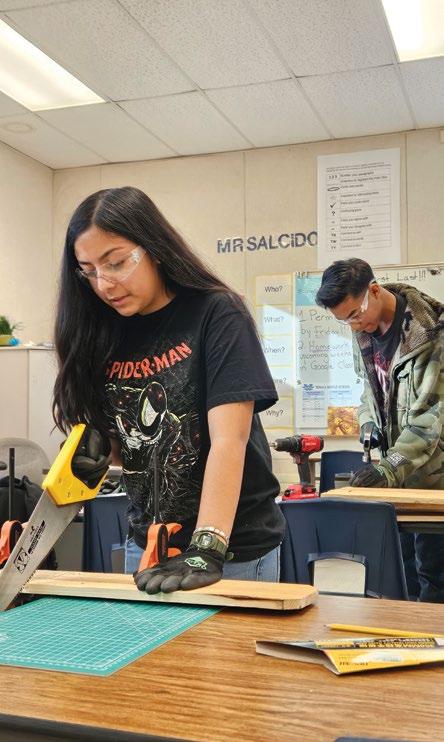
“First off, I learned on how to do 3D modeling with clay and then 3D modeling on the computer, which involves a bit of planning, and research on the web. And trying to find out what really fit in between those needs and try to make us solve problems and in a way that allowed us to do things. But that allowed us to do things much faster and easier to handle.”
Carlos explained that 3D modeling allowed him to solve problems more efficiently and helped him balance all the steps that come with making projects. The difference between his explanations of how he solved problems shows his growth as well as how this key skill contributed to building Carlos’s agency as a maker.
Conclusions
Carlos showed growth in his ability to explain math concepts and his making process more clearly in the way he was able to describe the need for accuracy of measurements in his project’s outcome. The program provided him with opportunities to consider careers related to the making skills
he learned. Carlos also identified the need for problem solving skills and discovered more efficient ways of making things through the program. The growth that Carlos experienced in the AMPED 4 Making project shows that bringing together math and making in informal learning environments can support math skills development, career exploration, and social skills development.
Learn More
AMPED website terc.edu/amped4making
Cesar Chavez Foundation chavezfoundation.org/innovation
References
Harper, D. (2002). Talking about pictures: A case for photo elicitation. Visual studies, 17(1), 13-26.
Levin-Güracar, E., Jaumot-Pascual, N., Rafanan, K., Lara-Meloy, T., Eways, J. & Mitchell, I. (2024, September 28-October 1). Object Elicitation Interviews: Engaging Youth in Conversations About Their STEM Learning Through Making [Conference presentation]. ASTC Annual Conference, Chicago, IL, United States.
Yin, R. K. (2003). Case study research: Design and methods (3rd ed.). Sage Publications.
Acknowledgements
This material is based upon work partially supported by the National Science Foundation. AMPED 4 Making is funded through the AISL Program (award #2215382). Any opinions, findings, and conclusions or recommendations expressed in this material are those of the author(s) and do not necessarily reflect the views of the National Science Foundation.
Authors
Nuria Jaumot-Pascual, Ph.D. (she/her/ella) is a Research Scientist at TERC. She researches the experiences in STEM education and
We are saddened to share that the AMPED 4 Making project was recently included in the widespread grant terminations at the National Science Foundation. While our interviews and observations confirmed the deep engagement of the middle school youth participating in the program, we will not be able to fully understand their learning outcomes or growth, as our final data collection— originally planned for May — can no longer take place. The program and student activities had five weeks remaining, and three years of funded work will now go without the dissemination it deserved.
The lack of dissemination means we will miss the opportunity to share valuable insights and promising
Math and Making for Middle School Youth
careers of populations that live at the intersection of interlocking marginalities, with an emphasis on gender and race/ethnicity. She currently co-leads several NSF-funded projects. Two of them use participatory and co-design methods to bring STEM and making to youth from groups that experience marginalization. She is also co-PI of two studies on the experiences of Native students and professionals in STEM and of a project that brings qualitative meta-synthesis methods to scholars focusing on equity in STEM. Dr. Jaumot-Pascual is a member of the research advisory board for the ADVANCE Resource and Coordination (ARC) Network. She specializes in qualitative, literature synthesis, and visual inquiry methods and holds a doctorate in Qualitative Research and Evaluation Methodologies from the University of Georgia.
Elise Levin-Güracar (she/her) is a math educator and researcher at TERC. She is on the design and research team for AMPED 4 Making. She studied education, public policy, and sociology at the University of California at Berkeley, and received her secondary math teaching credential after student teaching with a 7th-grade class. She continues to teach math to third- through eleventh-graders. As a maker, she enjoys gardening, playing with acrylic paint, and learning new crafts (most recently ceramics and water marbling).
Teresa Lara-Meloy is a Senior Math Education Designer at TERC and is PI on AMPED 4 Making and co-PI on AAMASE. Teresa is passionate about finding better ways of engaging middle schoolers in mathematical thinking and learning and improving ways to support math teachers and coaches. Additionally, she is interested in embodied mathematics, educator PD, and the mediation of languages in mathematical discourse
Vanessa Galeana (he/him) is senior in Education and Human Development at Boston University. He was an REU Intern at TERC during summer 2024, when he conducted data analysis with the AMPED 4 Making project. In addition to his studies, he is a Community School Lead Teacher for the City of Cambridge, MA, and a Team Leader for the Department of Parks, Recreation & Culture in Gaithersburg, MD.
practices that could benefit afterschool programs, educators, policymakers, and youth across the country who are seeking effective ways to integrate math and making in STEM learning. Without this critical information, the full impact of the project’s success and the lessons learned will not reach the wider field, potentially limiting future innovations in math education and youth STEM learning.
We are actively exploring future funding opportunities and new partnerships to continue this important work. We remain committed to supporting youth, afterschool educators, and communities in connecting mathematics with meaningful, creative making experiences.
MPACT
Math and Computational Thinking Through 3D Making
Computational Thinking Through 3D Making
Are you a multiple-subjects teacher, a math or computer science teacher, a STEAM specialist, or a librarian with a makerspace? These free ready-to-download design-andmaking units are for you!
About the Project
Project-based learning through making — helping students develop mathematical understanding, computational thinking, and spatial reasoning.
ĉ Four projects for each grade, 4th–7th, with research-based activities
ĉ Digital or paper booklets for students
ĉ Detailed teacher guides
ĉ Digital tools and traditional craft materials for most projects:
ç Free, kid-friendly 3D modeling tool — Tinkercad
ç Low-cost, high-quality 3D printers
ç Quick-dry clay, upcycled cardboard and plastic, etc.
ĉ Low-tech units do not require digital tools.
EXAMPLE FROM GRADE 5
Make the real thing
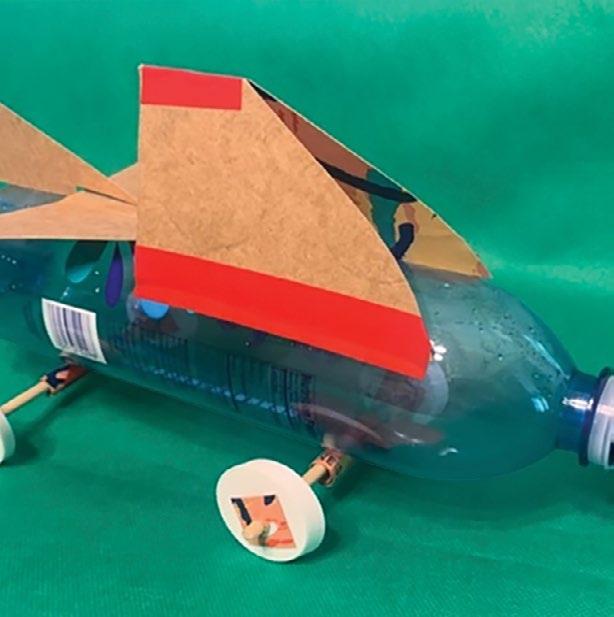
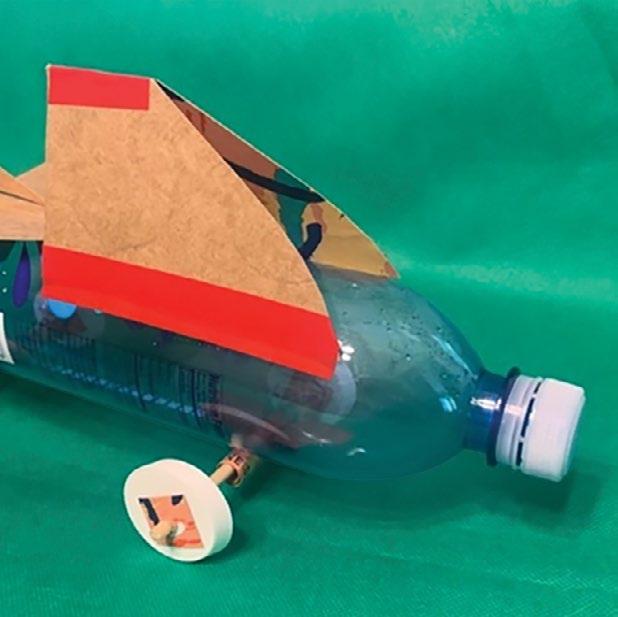
Collect ideas from your user
Iterate: make it better
Make and re-make prototypes
Students make a toy with wheels for a younger child. They
1. Learn about the needs of their user
2. Prototype designs with scrap paper and tape
3. Design wheels in Tinkercad and 3D print them
4. Make the rest of the toy with inexpensive or upcycled materials
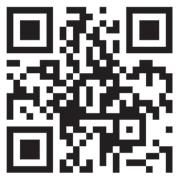
Design on computer and paper
PROVIDES OPPORTUNITES TO:
ĉ Learn about volume (math), devising and debugging algorithms (CS), and mental rotation (spatial reasoning)
ĉ Develop empathy, through making for another person
ĉ Gain workplace-related practices in design and making
The contents of the MPACT curriculum were developed under a grant from the Department of Education. However, those contents do not necessarily represent the policy of the Department of Education, and you should not assume endorsement by the Federal Government.
What’s New at TERC?
TERC Announces Christine Reich as New President
TERC, a leading nonprofit in STEM education research and development, is pleased to announce that Christine Reich, PhD, will join TERC as its president on July 1, 2025. A distinguished educator, social science researcher, and former museum executive, Reich brings a deep commitment to advancing STEM education opportunities for all learners.
Reich joins TERC from Knology, a social science research nonprofit, where she served as CEO and senior research officer, collaborating with media, libraries, museums, and community organizations to generate evidencebased insights for greater societal impact. She is also an adjunct lecturer at the Harvard Graduate School of Education, where she has taught for over a decade in the Learning Design, Innovation, and Technology program, and currently serves as President of the Visitor Studies Association.
With an extensive background in both out-of-school and K–12 STEM education, Reich has published research on topics such as organizational learning, emotional engagement, and informal science learning. She was honored as a “Champion of Change” by the Obama White House and named a fellow by the Noyce Leadership Institute.
Prior to her tenure at Knology, Reich served as the Jane and Payson Swaffield Chief Learning Officer at the Museum of Science in Boston, where she led the museum’s educational initiatives, including exhibits programs, curricula, immersive theaters, collections, and educational research. While at the Museum, she founded the Museum’s research and evaluation department (now one of the largest internal departments of its kind), led the research and evaluation team of the $43 million, NSF-funded Nanoscale Informal Science Education
Network (NISE Net), and oversaw the development of multiple award-winning exhibitions, including the internationally touring “The Science Behind Pixar” exhibition.
“Christine’s expertise in STEM learning and collaborative leadership style will be a tremendous asset to TERC. Her passion for increasing access to STEM programs will guide TERC into an exciting new chapter of impact and growth.”
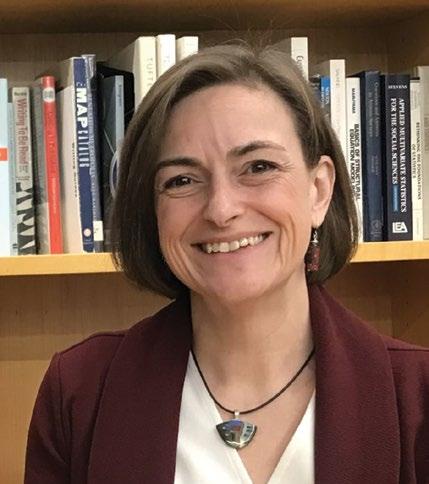
— NADINE BONDA, TERC BOARD CHAIR
For 60 years, TERC has been a pioneer in STEM education research, driven by the belief that every student deserves access to high-quality learning experiences. The organization is dedicated to advancing math and science education and continually pushes the boundaries of research and development to create meaningful impact. By meeting both educators and learners where they are, TERC provides the tools, resources, and support necessary for success in STEM learning.
“I’ve long admired TERC for its dedication to shaping the future of STEM education,” said Reich. “I look forward to working with the talented team to advance our shared mission and expand the reach of TERC’s work.”
Because math and science build futures
2067 Massachusetts Avenue • Cambridge, Massachusetts 02140
Tablet-alt terc.edu @terc-stem.bsky.social facebook TERCed tercstemed youtube @tercSTEMEd
Hands On! goes digital
TERC is excited to announce that the Fall 2025 issue of Hands On! will be delivered directly to your inbox. By choosing to receive this issue digitally, you can enjoy the convenience of accessing Hands On! anytime, anywhere.
Articles include:
ĉ TERC Celebrates 60 Years
ĉ STEM Workforce Stories in Classroom Settings
ĉ Distinctive Pedagogy of the Climate and Equity Institutes
Fill out this form to make sure you receive your digital copy.
